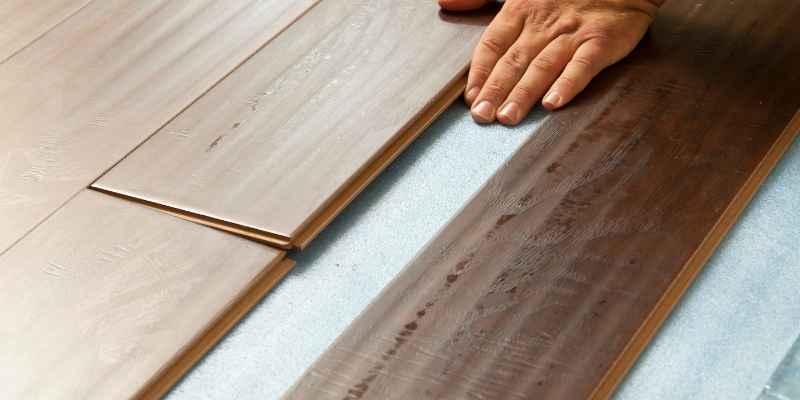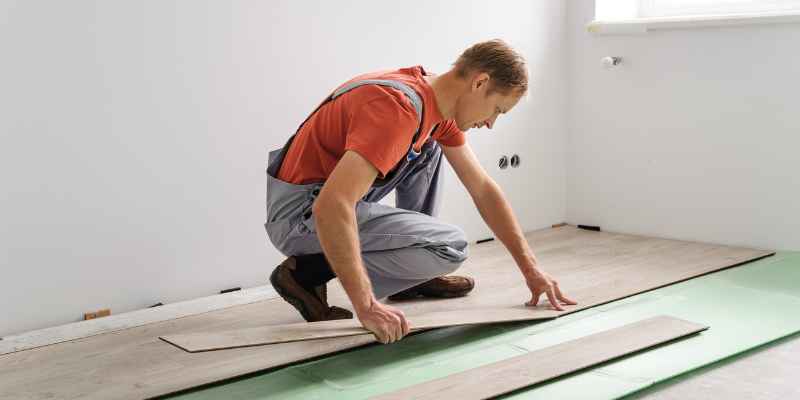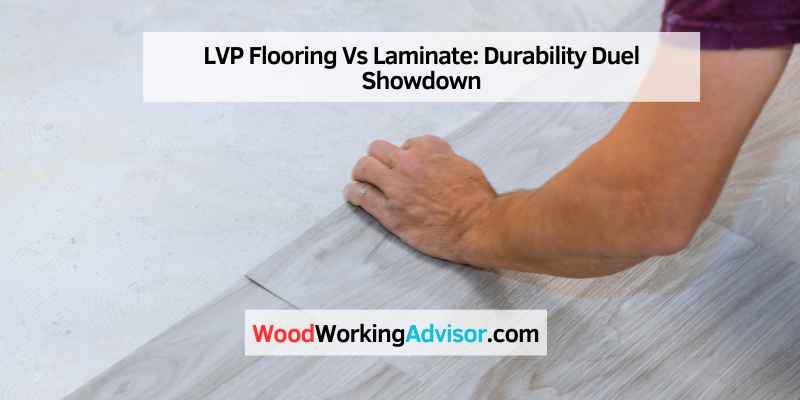LVP and laminate flooring are both durable options, but each has its own weaknesses. Laminate is prone to scratches and chipping over time, making vinyl a better choice for homes with pets.
LVP is scratch-resistant but can be vulnerable to denting and tearing. In terms of maintenance, both types of flooring are easy to clean, but laminate can be susceptible to scratches and gouges if not properly protected, while LVP is more resistant to damage but still requires proper maintenance to avoid scratches.
When it comes to choosing between the two, it ultimately depends on your specific needs and preferences. LVP (Luxury Vinyl Plank) flooring and laminate flooring are both popular choices for homeowners looking for durable flooring options. While each type of flooring has its own benefits, it’s important to understand the key differences between the two. We’ll explore the pros and cons of LVP and laminate flooring, including factors such as durability, maintenance, and cost. We’ll also take a closer look at how each type of flooring compares in terms of scratch resistance, water resistance, and other important factors to consider when choosing between LVP and laminate.
Introduction To Flooring Face-off
LVP flooring and laminate flooring are two popular choices for homeowners seeking durable and stylish flooring options. In this flooring face-off, we will compare the key features and benefits of these contenders to help you make an informed decision for your space.
First Contender: LVP Flooring
LVP, or Luxury Vinyl Plank flooring, is known for its durability and water resistance, making it ideal for high-traffic areas and moisture-prone spaces like bathrooms and kitchens.
Second Contender: Laminate Flooring
Laminate flooring is a versatile and cost-effective option that mimics the look of hardwood or stone at a fraction of the cost. It offers easy installation and low maintenance.

Composition Clash
Discover the ultimate showdown between LVP flooring and laminate. While LVP boasts scratch-resistance, laminate offers a warmer touch with its wood content. Consider durability, maintenance, and pet-friendliness to make the best choice for your home.
When it comes to choosing the right flooring for your home, the battle between LVP (Luxury Vinyl Plank) and laminate flooring can be intense. One aspect to consider is the composition of these two types of flooring. In this section, we will dive into the layers that make up LVP and laminate flooring, providing you with a better understanding of their composition clash.
LVP Layers Explained
LVP flooring is composed of multiple layers that work together to create a durable and visually appealing surface. Let’s unpack each layer:
- Wear Layer: This is the topmost layer of LVP flooring, responsible for protecting the floor from scratches, stains, and fading.
- Print Layer: Beneath the wear layer lies the print layer, which features a high-resolution image that mimics the look of real wood or stone.
- Core Layer: The core layer provides stability and durability to the LVP flooring. It is usually made of PVC (polyvinyl chloride) or SPC (stone plastic composite).
- Backing Layer: The backing layer serves as a moisture barrier, preventing any potential damage from subfloor moisture.
Laminate Layers Unpacked
Laminate flooring, on the other hand, has its own unique composition. Let’s take a closer look at the layers that make up laminate flooring:
- Wear Layer: Similar to LVP, laminate flooring also has a wear layer that protects against scratches, stains, and fading.
- Print Layer: The print layer of laminate flooring features a high-resolution image of wood or stone, giving it a realistic appearance.
- Core Layer: Unlike LVP, the core layer of laminate flooring is typically made of high-density fiberboard (HDF), which provides stability and strength.
- Backing Layer: Just like LVP, laminate flooring also has a backing layer that acts as a moisture barrier.
Both LVP and laminate flooring share similarities in their composition, such as the wear layer, print layer, and backing layer. However, the core layer sets them apart, with LVP using PVC or SPC and laminate utilizing HDF.
Understanding the composition of LVP and laminate flooring is crucial in making an informed decision for your home. Consider the specific needs of your space, such as moisture resistance or durability, before choosing between these two popular flooring options.
Aesthetic Appeal
When it comes to enhancing the visual appeal of your space, the choice between LVP flooring and laminate can significantly impact the overall aesthetic. Let’s explore the visual varieties and captivating looks that each of these flooring options has to offer.
Visual Varieties Of LVP
LVP flooring comes in a wide array of visual styles, ranging from natural wood and stone designs to modern and eclectic patterns. The advanced printing technology used in the production of LVP allows for intricate detailing, realistic textures, and vibrant colors, providing an extensive selection to suit diverse design preferences.
Laminate Looks Showcase
Laminate flooring boasts an impressive showcase of looks that replicate the appearance of hardwood, tile, and stone. With high-definition imaging and embossing techniques, laminate floors capture the authentic textures and grain patterns of natural materials, offering a cost-effective way to achieve the luxurious aesthetics of traditional hardwood or tile flooring.
Installation Battle
When comparing LVP flooring and laminate, the installation process plays a crucial role in determining which option is more convenient and efficient for your space.
Ease Of LVP Installation
Installing LVP flooring is relatively easy and straightforward, making it ideal for DIY enthusiasts or those looking to save on installation costs.
- Click-lock designs allow for simple interlocking without the need for adhesives.
- Flexible installation options such as floating installation make it suitable for various subfloor types.
Laminate Laying Techniques
Laminate flooring installation involves specific techniques to ensure a proper and long-lasting finish.
- Acclimating the planks to the room’s temperature and humidity levels is crucial before installation.
- Careful cutting and measuring are necessary to achieve a seamless and professional look.
Durability And Damage
LVP flooring offers superior durability compared to laminate. While laminate is prone to scratches and chipped corners over time, LVP is more scratch-resistant. However, LVP is more susceptible to denting and tearing, making it essential to consider the specific needs of your space when choosing between the two options.
Scratch And Dent Resistance In LVP
LVP flooring, also known as luxury vinyl plank, is renowned for its exceptional scratch resistance. The durable wear layer protects the surface from scratches and scuffs, making it an ideal choice for high-traffic areas and homes with pets.
Additionally, LVP’s resilience against dents is noteworthy. While it’s more vulnerable to denting compared to laminate, it still offers excellent resistance, especially in comparison to traditional vinyl flooring.
Laminate’s Lifespan Limitations
Laminate flooring, while durable, has a lifespan that is limited by its susceptibility to scratches and chipped corners over time. This makes it less suitable for homes with pets or areas prone to heavy wear and tear.
Moreover, laminate’s vulnerability to damage can impact its longevity, as it cannot be refinished once its surface deteriorates. This limitation contrasts with options that can be refinished, ultimately impacting the flooring’s lifespan.
Moisture And Maintenance
LVP flooring and laminate are both durable options, but they have their differences. Laminate is prone to scratches and chipped corners over time, making LVP a better choice for homes with pets. On the other hand, LVP is more susceptible to denting and tearing.
When it comes to maintenance, both types of flooring are fairly easy to clean, but laminate can be more prone to scratches if not properly protected. In terms of lifespan, LVP cannot be refinished, so once it deteriorates, it needs to be replaced.
Moisture and Maintenance are two crucial factors to consider when choosing between LVP Flooring and Laminate. Both types of flooring have their own unique characteristics and requirements when it comes to dealing with moisture and maintenance. Let’s take a closer look at each one.
LVP’s Water Warfare
Luxury Vinyl Plank (LVP) flooring is known for its exceptional resistance to water. Unlike laminate, LVP can withstand exposure to water without suffering damage or warping. This makes it an ideal choice for areas of the home that are prone to moisture, such as bathrooms, kitchens, and basements. With LVP, you won’t have to worry about spills or leaks causing damage to your flooring. Additionally, LVP is easy to clean and maintain, requiring only regular sweeping and occasional mopping to keep it looking its best.
Laminate And Liquid: A Risky Relationship
Laminate flooring, on the other hand, is not as water-resistant as LVP. While newer laminate options are more water-resistant than older versions, they are still at risk of damage from prolonged exposure to moisture. Laminate flooring can warp, swell, or even buckle if it is exposed to standing water or high humidity levels. This makes it less suitable for areas of the home that are prone to moisture. It’s also important to note that laminate flooring can be more difficult to clean and maintain than LVP, requiring special care to avoid scratches, dents, and other types of damage.
In conclusion, when it comes to moisture and maintenance, LVP flooring is the clear winner. Its superior water resistance and easy maintenance make it a great choice for any home, especially in areas that are prone to moisture. However, if you prefer the look of laminate or have a limited budget, it’s still possible to make it work with proper care and attention. Ultimately, the choice between LVP and laminate will depend on your personal preferences and needs.

Cost Comparison
When it comes to choosing between LVP flooring and laminate, the cost is a crucial factor to consider. Both options offer budget-friendly alternatives to traditional hardwood flooring, but it’s important to evaluate the cost comparison to make an informed decision.
Price Point Of LVP
Luxury Vinyl Plank (LVP) flooring is known for its affordability, making it an attractive option for budget-conscious homeowners. The price of LVP typically ranges from $2 to $5 per square foot, depending on the quality and design. This makes LVP a cost-effective choice for those looking to achieve the look of hardwood without breaking the bank.
Evaluating Laminate’s Economy
Laminate flooring also offers a wallet-friendly alternative to hardwood, with prices ranging from $1 to $4 per square foot. While the upfront cost may be slightly lower than LVP, it’s essential to consider the long-term durability and maintenance requirements of laminate to determine its overall economy.
One key factor to consider when evaluating the cost of laminate flooring is the potential for replacement or repairs due to wear and tear over time. While the initial investment may be lower, the need for future maintenance and potential replacement can impact the overall cost in the long run.
Environmental Impact
The environmental impact of flooring materials is an important consideration for eco-conscious consumers. When it comes to LVP flooring vs laminate, it’s essential to evaluate their eco-footprint and green grade to make an informed choice.
LVP’s Eco-footprint
LVP, or luxury vinyl plank, is considered to have a relatively low environmental impact due to its composition and manufacturing process. It is typically made from PVC (polyvinyl chloride) and other synthetic materials, which are not biodegradable. However, advancements in technology have led to the development of eco-friendly LVP options that incorporate recycled materials and utilize sustainable production methods.
Laminate’s Green Grade
Laminate flooring, on the other hand, is often criticized for its environmental impact. The production of laminate involves the extensive use of wood, which raises concerns about deforestation and habitat destruction. Additionally, the adhesives and resins used in laminate production may contain volatile organic compounds (VOCs) that can contribute to indoor air pollution.
Consumer Considerations
When choosing between LVP flooring and laminate, consider that LVP is more scratch-resistant, making it ideal for homes with pets. Laminate, on the other hand, may be prone to scratches and chipped corners over time. Each option has its strengths and weaknesses to weigh.
LVP In Living Spaces
If you’re looking for a flooring option that’s perfect for high-traffic areas like the living room, kitchen, or entryway, luxury vinyl plank (LVP) flooring may be the way to go. LVP is highly durable and water-resistant, making it perfect for families with kids and pets. It’s also easy to clean and maintain, requiring only regular sweeping and occasional mopping. Plus, LVP comes in a wide variety of styles and colors, so you’re sure to find a look that fits your home’s aesthetic.
Laminate For Lifestyle Needs
While LVP is a great option for some households, laminate flooring may be a better choice for others. Laminate is also durable and easy to clean, but it’s less water-resistant than LVP, so it may not be the best choice for kitchens or bathrooms. However, laminate is often more affordable than LVP, making it a great option for those on a budget. And with its realistic wood-look design, laminate can be a great choice for homeowners who want the look of hardwood floors without the high cost.
When it comes to choosing between LVP and laminate flooring, there are a few key factors to consider. For households with pets or young children, LVP may be the better choice due to its water resistance and durability. However, if you’re looking for a more affordable option or prefer the look of traditional hardwood floors, laminate may be the way to go. Ultimately, the decision between LVP and laminate comes down to your personal preferences and lifestyle needs.
Final Flooring Verdict
In the ongoing debate of LVP flooring vs laminate, both options have their pros and cons. While laminate is prone to scratches and chipped corners over time, LVP is more scratch-resistant but can be vulnerable to denting and tearing. Ultimately, the choice between the two will depend on factors such as durability, maintenance, and the presence of pets in your home.
Summarizing The Showdown
When it comes to choosing between LVP (Luxury Vinyl Plank) flooring and laminate, it’s essential to consider various factors to determine the best option for your home. Both options have their strengths and weaknesses, so it’s crucial to weigh them carefully.
Choosing The Champion For Your Home
In conclusion, the final decision depends on your specific needs and preferences. If you prioritize durability and water resistance, LVP flooring may be the better choice. On the other hand, if you’re aiming for a more budget-friendly option with a wide range of designs, laminate flooring could be the winner. Ultimately, it’s essential to assess your lifestyle, maintenance preferences, and budget constraints before making your final flooring decision.
Frequently Asked Questions
Is LVP Better Than Laminate?
LVP is better than laminate due to its scratch resistance, making it ideal for homes with pets. Laminate is prone to scratches and chipped corners over time.
What Are The Cons Of LVP?
The cons of LVP include the fact that it cannot be refinished, leading to a shorter lifespan compared to other flooring options that can be refinished. LVP is also vulnerable to denting and tearing, and although it is scratch-resistant, it can still be scratched or gouged if not properly maintained.
In comparison, laminate flooring can be susceptible to scratches and chipped corners over time, making vinyl a better choice for homes with pets.
Does Vinyl Flooring Scratch Easier Than Laminate?
Laminate flooring is prone to scratches and chipped corners, while vinyl flooring is more scratch-resistant. However, LVT/LVP is vulnerable to denting and tearing. Both types of flooring are easy to maintain, but laminate floors require proper protection to avoid scratches and gouges.
While LVP floors are more resistant to damage, they can still be scratched or gouged if not properly maintained. Ultimately, the choice between the two depends on individual preferences and needs.
What Flooring Is Better Than LVP?
Engineered wood flooring offers durability and the aesthetic of real wood, making it a superior choice to LVP.
Conclusion
When deciding between LVP flooring and laminate, consider durability and maintenance. LVP is scratch-resistant and better for pets. Laminate can scratch easily if not protected. Both have pros and cons, so choose wisely for your home. Research and compare to make the best decision.

